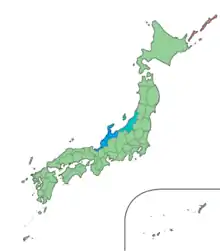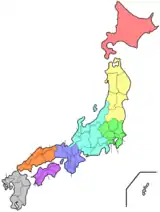Hokuriku region
The Hokuriku region (北陸地方, Hokuriku chihō) was located in the northwestern part of Honshu, the main island of Japan. It lay along the Sea of Japan within the Chūbu region, which it is currently a part of.[1] It is almost equivalent to Koshi Province and Hokurikudō area in pre-modern Japan. Due to its elongated shape, and the Noto Peninsula jutting out, the region is known as a 'rising dragon' 昇龍道 (しょうりゅうどう, Shōryūdō).[2][3] Since the Heian period until the Edo period the region was a core recipient of population, the population grew to be much larger proportionately than it is today, despite the rural character. With the growth of urban centers in the 20th century, particularly Tokyo and Chūkyō, the Hokuriku has steadily declined in importance to become relative backwaters. The region is also known for traditional culture that originated from elsewhere that has been long lost along the Taiheiyō Belt.

The Hokuriku region includes the four prefectures of Ishikawa, Fukui, Niigata and Toyama,[4] although Niigata is sometimes included in one of the following regions:
- Shin'etsu (信越): includes Niigata and Nagano prefectures
- Kōshin'etsu (甲信越): includes Niigata, Nagano and Yamanashi prefectures
- Hokushin'etsu (北信越): includes both the Hokuriku and Shin'etsu regions
Major cities
The major population centers of Hokuriku are:
Of these, Niigata is the largest with a population of over 800,000.
Industries
The main industries in the Hokuriku area include chemicals, medicine, tourism, textiles and textile machinery, heavy machinery, farming, and fishing. Koshihikari, a popular variety of rice is a special product of Hokuriku subregion.
Demographics
Per Japanese census data,[5] and,[6] Hokuriku subregion has had negative population growth since year 2000.
| Year | Pop. | ±% |
|---|---|---|
| 1920 | 3,846,000 | — |
| 1930 | 4,087,000 | +6.3% |
| 1940 | 4,289,000 | +4.9% |
| 1950 | 5,179,000 | +20.8% |
| 1960 | 5,201,000 | +0.4% |
| 1970 | 5,137,000 | −1.2% |
| 1980 | 5,467,000 | +6.4% |
| 1990 | 5,584,000 | +2.1% |
| 2000 | 5,606,505 | +0.4% |
| 2010 | 5,443,799 | −2.9% |
| 2020 | 5,186,388 | −4.7% |
Climate
The Hokuriku region has the highest volume of snowfall of any inhabited and arable region in the world. This is because dry Siberian air masses, which develop high humidity over the Sea of Japan, are forced upwards when they encounter the mountains of Honshū, causing the humidity to condense as snow.
The long winters and deep snow of this region are depicted in Hokuetsu Seppu, an encyclopedic work of the late Edo period which describes life in the Uonuma district of Niigata Prefecture.
The Hokuriku region is also the setting for Yasunari Kawabata's novel Snow Country.
Tourism
Hokuriku is listed as No. 4 in Lonely Planet's Best in Travel 2014 – Top 10 Regions.[7] The region has seen an influx of tourists since 2015 as the Hokuriku Shinkansen (formerly Nagano Shinkansen) extended its services from Nagano to Kanazawa, enabling direct bullet train services to the Hokuriku region from Tokyo. When services commenced in March 2015, the travel time from Tokyo to Toyama was reduced to about 2 hours, with Kanazawa an additional 30 minutes away.[8]
See also
Notes
- Nussbaum, Louis-Frédéric. (2005). "Chūbu" in Japan Encyclopedia, p. 126, p. 126, at Google Books.
- "Archived copy". Archived from the original on 2017-02-25. Retrieved 2017-02-25.CS1 maint: archived copy as title (link)
- "Archived copy". Archived from the original on 2018-01-15. Retrieved 2017-02-25.CS1 maint: archived copy as title (link)
- Nussbaum, "Hokuriku" at p. 344, p. 344, at Google Books.
- Niigata 1995-2020 population statistics
- Hokuriku subregion 1920-2000 population statistics
- Planet, Lonely. "Lonely Planet's Best in Travel 2014 - top 10 regions". Lonely Planet. Retrieved 2021-01-31.
- "Hokuriku Shinkansen line between Nagano, Kanazawa completed - AJW by The Asahi Shimbun". web.archive.org. 2014-05-28. Retrieved 2021-01-31.
References
- Nussbaum, Louis-Frédéric and Käthe Roth (2005). Japan Encyclopedia. Cambridge, Massachusetts: Harvard University Press. OCLC 58053128. ISBN 0-674-01753-6, ISBN 978-0-674-01753-5.




.jpg.webp)


